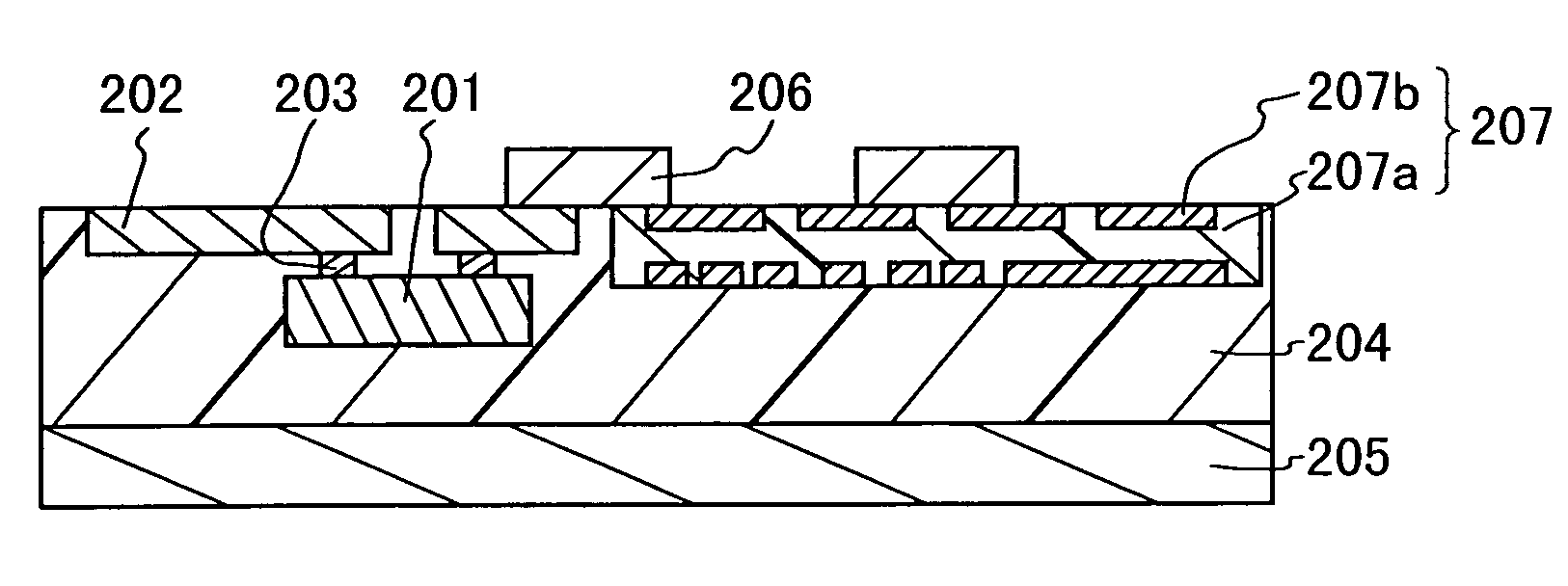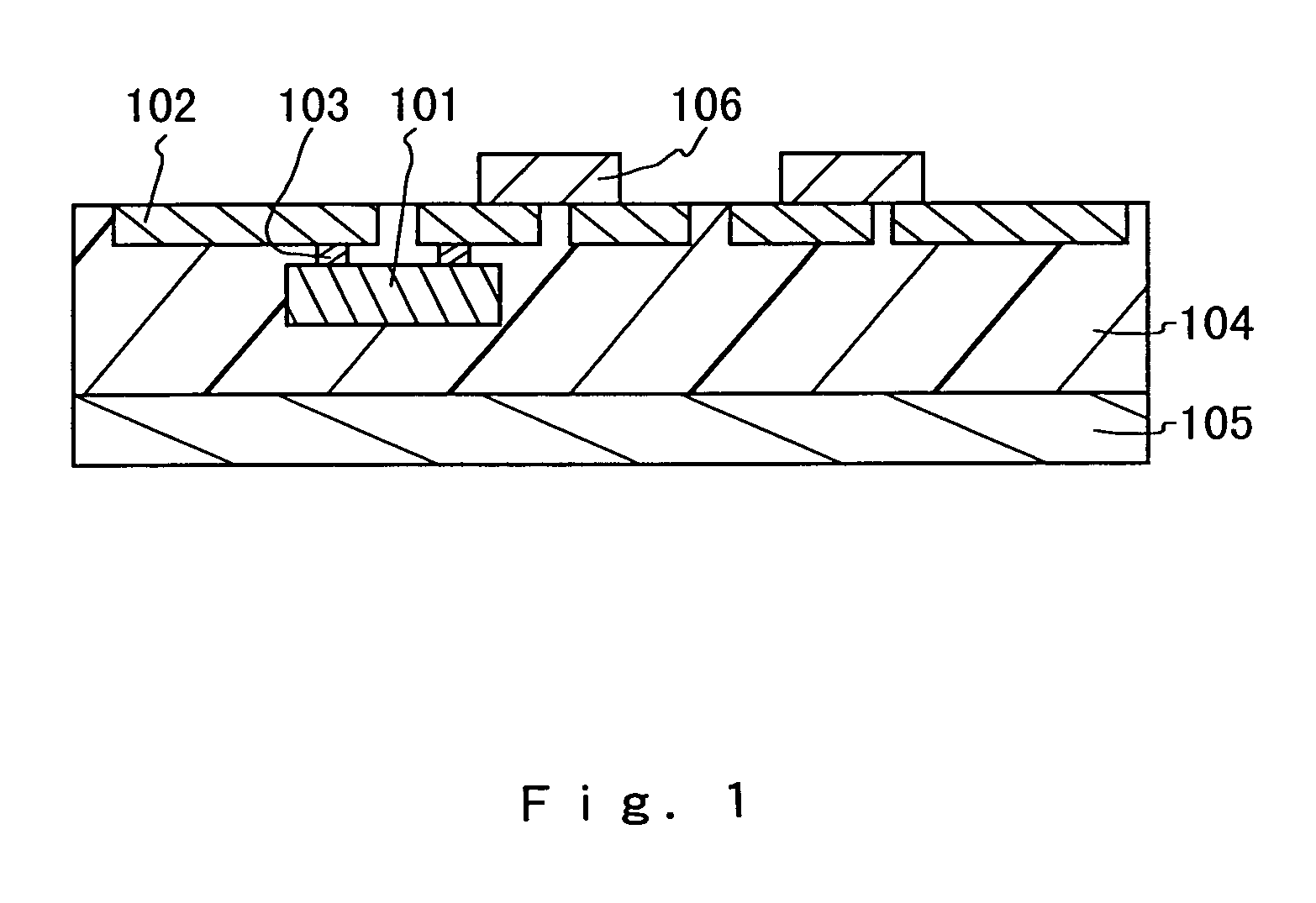Power module with improved heat dissipation
a power module and heat dissipation technology, applied in the field of power modules, can solve the problems of inability to improve thermal conductivity remarkably, difficult to fill inorganic fillers with high density, and difficult to improve heat dissipation structure of power modules, so as to and improve heat dissipation efficiency.
- Summary
- Abstract
- Description
- Claims
- Application Information
AI Technical Summary
Benefits of technology
Problems solved by technology
Method used
Image
Examples
first embodiment
[0123]A power module configured as shown in FIG. 1 was produced in the following process steps. First, a polyphenylene sulphide (PPS) film 50 μm in thickness was prepared as a release carrier and a rubber-based adhesive was applied on the surface of the release carrier to be 10 μm in thickness. A copper foil 250 μm in thickness was bonded to the adhesive-applied surface of the release carrier by a roll-laminate method. After laminating a dry film on the copper foil surface, the dry film was exposed through a mask formed with a wiring pattern, and developed to remove the dry film in a portion other than the exposed portion. Next, unnecessary portions of the copper foil were removed by dipping in a solution of ferric chloride, and then, the dry film was further removed by using sodium hydroxide, so that a lead frame was formed.
[0124]Next, a semiconductor chip was flip-chip mounted on the lead frame. An IGBT for current of 50 A (manufactured by Matsushita Electronics Corporation) was u...
second embodiment
[0134]Sheet-like insulators were produced by printing insulating pastes of the respective compositions shown in Table 1 on PPS films (75 μm in thickness), drying, and further by laminating second PPS films and curing by heat and pressure.
[0135]
TABLE 1ThermosettingColor-Cou-Sam-Inorganic fillersresin compositioningDisper-plingpleAmountAmountagentsantagentNo.Type(wt %)Type(wt %)(wt %)(wt %)(wt %)1Al2O365Epoxy340.50.30.2resin2Al2O390Epoxy90.50.30.2resin3SiO270Epoxy290.50.30.2resin4SiO275Epoxy240.50.30.2resin5SiO280Epoxy190.50.30.2resin6SiO285Epoxy140.50.30.2resin7MgO75Epoxy240.50.30.2resin8MgO85Epoxy140.50.30.2resin9BN75Epoxy240.50.30.2resin10BN85Epoxy140.50.30.2resin
[0136]In this embodiment, an epoxy resin composition compring 90 wt % of bisphenol F epoxy resin (manufactured by Yuka Shell Epoxy Co., Ltd.), 3 wt % of an amine adduct (“MY-H” manufactured by Ajinomoto Co., Inc.) as a hardening agent, and 7 wt % of imidazole as a hardening accelerator was used.
[0137]The Al2O3 was “AS-40” ...
third embodiment
[0146]A power module configured as shown in FIG. 1 was produced in the following manner. First, a lead frame was formed on a release carrier, and a semiconductor chip was flip-chip mounted on the lead frame in the same manner of First Embodiment.
[0147]Next, a solvent of methyl ethyl ketone was added to a resin composition comprising the following substances before rotational mixing in a pot comprising an alumina ball for 48 hours at a speed of 500 rpm to prepare slurry. The amount of the methyl ethyl ketone solvent to be added was controlled to adjust the slurry's viscosity to be about 20 Pa·s.
[0148](1) 85 wt % of AlN (manufactured by Dow Chemical Co. Ltd., the average particle diameter of 12 μm)
[0149](2) 14 wt % of a cyanate resin composition (manufactured by Asahi Ciba with a trade name of “AroCy M-30”)
[0150](3) 0.3 wt % of carbon black (manufactured by Toyo Carbon)
[0151](4) 0.2 wt % of a dispersant (manufactured by Dai-ichi Kogyo Seiyaku Co., Ltd. with a trade name of “Prysurf F-...
PUM
 Login to View More
Login to View More Abstract
Description
Claims
Application Information
 Login to View More
Login to View More - R&D
- Intellectual Property
- Life Sciences
- Materials
- Tech Scout
- Unparalleled Data Quality
- Higher Quality Content
- 60% Fewer Hallucinations
Browse by: Latest US Patents, China's latest patents, Technical Efficacy Thesaurus, Application Domain, Technology Topic, Popular Technical Reports.
© 2025 PatSnap. All rights reserved.Legal|Privacy policy|Modern Slavery Act Transparency Statement|Sitemap|About US| Contact US: help@patsnap.com



